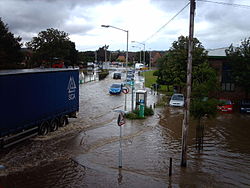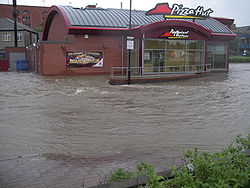2007 United Kingdom floods
The 2007 floods in the United Kingdom were a series of major floods that happened in many places across the country during June and July 2007.
In Gloucestershire, there was a flash flood from the River Severn and a lot of extreme rainfall. It is estimated that 13 people were killed and nearly all of Gloucestershire was trapped in their homes for the summer holidays. The water was around four foot deep, and it got into most people's homes. The repairs would have cost about 3 thousand pounds per home.
Effects
- Primary effects
- In July 2007, thirteen people were killed after the River Severn burst its banks.
- 10,000 motorists were stranded overnight.
- Farmers lost crops.
- 350,000 people were without running water after the sewage treatment plant was submerged.
- Houses and buildings were flooded and ruined.
- Electricity in Gloucester was shut down.
- Schools and businesses were unable to travel or work and were shut down.
- Significant damage to most properties in the area with nearly 50,000 homes affected, with people losing treasured, personal belongings and made homeless- staying with friends or relatives and 850 families had to stay in caravans, some up to Christmas 2008.
- Infrastructure severely affected, with roads cut off and badly damaged.
- On 22nd May water treatment works shut down. The media reporting’s of imminent loss of supplies, meant usage doubled and led to water depletion. By 24 July, 140,000 properties in Gloucestershire had no water supply. Alternative water supplies by bottles, bowsers and tankers had to be used. Water supplies were not fully restored until 1 August.
- Secondary effects
- Shops had better business because people needed more supplies.
- £3 billion had to be spent on repairs.
- Some businesses lost income while they had to repair buildings.
- 9,000 businesses affected
- More than 180,000 insurance claim
Responses
- People helped each other, creating a sense of community.
- Children were taught in temporary classrooms without books.
- Sandbags were distributed. (25,000)
- 200 tonnes of sand used
- Flood barriers were put in place.
- Bottled water was given out.
- 5 million liters of water distributed through 85 different places
- People who lost their homes were forced to live with relatives or caravans for up to two years.
2007 United Kingdom Floods Media
Cyclone Uriah crossing the United Kingdom on 25 June. Associated heavy rainfall led to flooding across northern England, particularly in Sheffield.
Non-administrative counties in England affected in June and July 2007 floods as of 24 July (marked in blue)
Administrative counties in England affected in June and July 2007 floods as of 24 July (marked in blue)
Flooding outside Thatcham railway station on 20 July
A flooded Pizza Hut in Chesterfield
Rising River Severn at Ironbridge, Shropshire, 28 June








